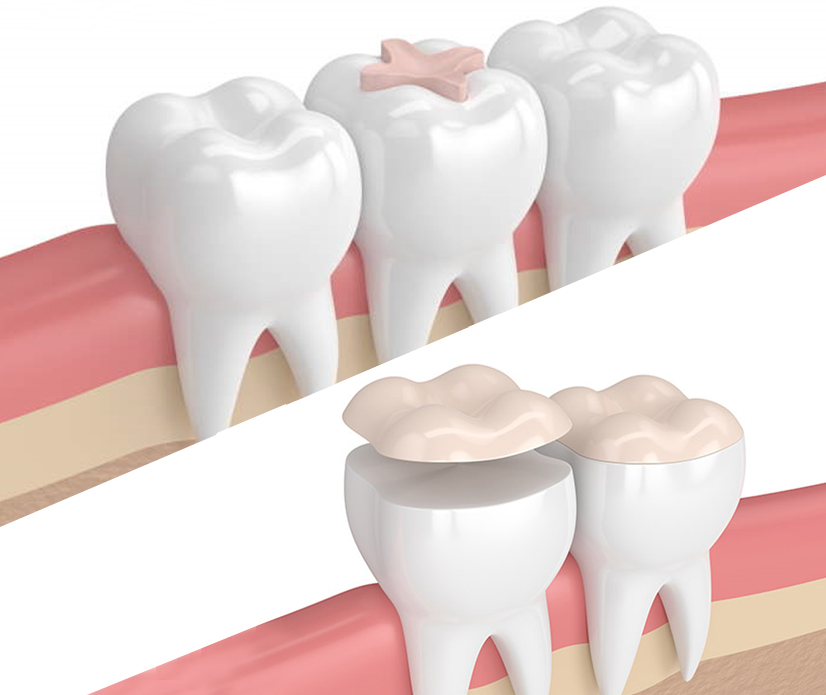Crowns, Inlays, Onlays & Bridgework In Sutton Coldfield, Birmingham
Restore The Function & Appearance Of Your Teeth
Dental crowns and bridges are two common restorative dental procedures that help to restore the function and appearance of your teeth. A dental crown is a prosthetic cap that is placed over a damaged tooth, while a dental bridge is a device that is used to replace one or more missing teeth.
Dental Crowns:
Dental crowns are used to restore teeth that have been damaged due to decay, injury, or other issues. They can also be used to cover teeth that have undergone root canal therapy. Crowns are typically made from a variety of materials, including porcelain, metal, or a combination of the two.
Dental Bridges:
Dental bridges are used to replace one or more missing teeth. They consist of a prosthetic tooth (or teeth) that is supported by adjacent natural teeth or dental implants. The prosthetic tooth is typically made from porcelain or a combination of materials, and is designed to match the patient’s natural teeth in size, shape, and colour.

Restorative Dental Treatment - Crowns, Inlays, Onlays & Bridges
Your dentist at Four Oaks Dental will choose which restoration treatment is best for you. There are multiple factors involved when making that decision, such as size of the restoration, location in the mouth, and biting forces applied to the area. The following restoration methods can be used to repair your tooth if a dental filling is not an option.

Crowns
Dental crowns, also known as dental caps, are custom-made tooth-shaped prostheses that are used to cover and protect damaged or decayed teeth. Crowns are typically made from a variety of materials, including porcelain, metal, or a combination of both. The procedure for placing a dental crown involves removing any decayed or damaged tooth structure, shaping the remaining tooth to fit the crown, taking an impression of the tooth, and then sending the impression to a dental laboratory where the crown is fabricated. The crown is then cemented onto the tooth using a special dental adhesive.

Inlays & Onlays
Inlays and onlays are similar to dental crowns in that they are custom-made prostheses that are used to restore damaged or decayed teeth. However, inlays and onlays are typically used to treat smaller areas of damage or decay that do not require a full dental crown. Inlays are used to fill in cavities or other areas of tooth decay that are too large for a filling but not large enough to require a crown. Onlays are used to treat similar areas of damage but also extend over one or more cusps of the tooth. The procedure for placing inlays and onlays is similar to that of dental crowns and involves removing any decayed or damaged tooth structure, taking an impression of the tooth, and then cementing the inlay or onlay onto the tooth using a special dental adhesive.

Bridges
Dental bridges are another common restorative dental procedure that are used to replace missing teeth. Bridges are made up of two or more dental crowns that are attached to the teeth on either side of the missing tooth or teeth, with a false tooth or teeth (called a pontic) in between. The procedure for placing a dental bridge involves preparing the teeth on either side of the missing tooth or teeth, taking an impression of the teeth, and then sending the impression to a dental laboratory where the bridge is fabricated. The bridge is then cemented onto the prepared teeth using a special dental adhesive.

A bridge restores a missing tooth and fills the gap in your smile.
They work by using crowns fitted over the teeth either side of the gap as supports for the replacement false tooth.
Bridges are fixed into place, and therefore are a more secure alternative to a partial denture.
Why have a bridge?
If you have a missing tooth, it is important to replace it. A gap in your smile can really affect your confidence and also cause alignment issues for your remaining teeth. A missing tooth can also affect your facial structure and shape as the existing teeth shift out of position and the support they give to your face decreases. Bridges can alleviate these issues, and also protect the otherwise vulnerable gum in the gap.





